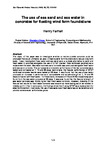The use of sea sand and sea water in concretes for floating wind farm foundations
| dc.contributor.author | Farnell, H. | |
| dc.date.accessioned | 2020-10-10T19:03:08Z | |
| dc.date.available | 2020-10-10T19:03:08Z | |
| dc.date.issued | 2020 | |
| dc.identifier.citation |
Farnell, H. (2020) ‘The use of sea sand and sea water in concretes for floating wind farm foundations’, The Plymouth Student Scientist, 13(1), p. 173-202. | en_US |
| dc.identifier.uri | http://hdl.handle.net/10026.1/16510 | |
| dc.description.abstract |
The object of this paper was to investigate whether a marine durable concrete could be produced that could ultimately be used in floating wind farm foundations to reduce long term costs. It was investigated if sea water and sea sand were a suitable alternative to sand and fresh water in concrete alongside the use of CFRP (Carbon fibre reinforced polymer) as a replacement for steel. Sea water and sea sand concrete was produced alongside fresh water and sea sand concrete. The compressive and tensile performance of the two concretes were tested and compared at 7, 14 and 28 days. Additionally, the flexural performance of CFRP reinforced concrete beams were tested at 28 days. It was found that the use of sea water produced an increase in performance of compressive and tensile strength at 7, 14 and 28 days compared with fresh water. For these tests, increases of 7.3 and 6.4% respectively were found from the sea water concrete at 28 days. It was also found that the flexural strength of sea water concrete was 18.3% higher than fresh water concrete. However, reliability of the flexural test results for fresh water concrete was low and so more testing would be needed to reliably confirm this. In conclusion, the findings show that if using CFRP as a replacement for steel reinforcement in concrete, the use of sea water over fresh water would be beneficial and provide considerable performance gains. | en_US |
| dc.language.iso | en | en_US |
| dc.publisher | University of Plymouth | en_US |
| dc.rights | Attribution 3.0 United States | * |
| dc.rights.uri | http://creativecommons.org/licenses/by/3.0/us/ | * |
| dc.subject | sea sand | en_US |
| dc.subject | sea water | en_US |
| dc.subject | concretes | en_US |
| dc.subject | floating wind farm | en_US |
| dc.subject | foundations | en_US |
| dc.subject | compressive performance | en_US |
| dc.subject | tensile performance | en_US |
| dc.subject | fresh water concrete | en_US |
| dc.subject | sea water concrete | en_US |
| dc.subject | CFRP | en_US |
| dc.subject | Carbon fibre reinforced polymer | en_US |
| dc.title | The use of sea sand and sea water in concretes for floating wind farm foundations | en_US |
| dc.type | Article | en_US |
| plymouth.issue | 1 | |
| plymouth.volume | 13 | |
| plymouth.journal | The Plymouth Student Scientist |




